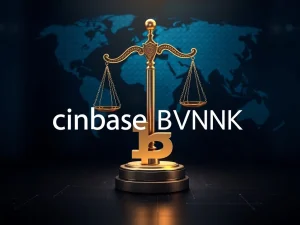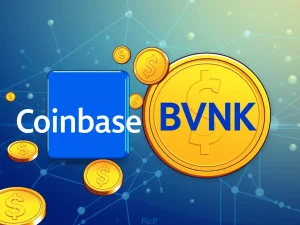Russia Reveals Bold Stablecoin Strategy Amid Crypto Sanction Pressure

In a dramatic turn of events in the digital finance landscape, Russia is reportedly exploring the creation of its own national stablecoin. This potential move comes in the wake of increased scrutiny and sanctions from international bodies, particularly after the US authorities and Tether froze wallets linked to the Russian crypto exchange Garantex. Is this a strategic pivot by Moscow to safeguard its digital assets and financial autonomy? Let’s dive into the details.
Navigating Sanctions: Russia’s Stablecoin Ambition
According to recent reports from Reuters and TASS, a high-ranking official from Russia’s Finance Ministry, Osman Kabaloev, has indicated that the nation should seriously consider developing a stablecoin, much like Tether’s USDT. This consideration is not happening in a vacuum; it’s a direct response to the recent actions against Garantex, a Russian crypto exchange that faced sanctions and asset freezes. The freeze, initiated by the US Department of Justice and stablecoin issuer Tether, highlighted the vulnerabilities of using international stablecoins in the current geopolitical climate.
Kabaloev stated, “We do not impose restrictions on the use of stablecoins within the experimental legal regime. Recent developments have shown that this instrument can pose risks for us.” He further added, “This leads us to consider the need to develop internal instruments akin to USDT, potentially pegged to other currencies.” This statement clearly underscores Russia’s intent to create a sovereign-controlled digital currency to mitigate risks associated with reliance on external crypto financial instruments.
Why is Russia Eyeing its Own Stablecoin?
The impetus behind Russia’s stablecoin consideration is multifaceted. Here are some key reasons:
- Sanction Resilience: The freezing of Garantex-linked wallets served as a stark reminder of the potential for external powers to disrupt Russia’s crypto operations. A domestically controlled stablecoin could offer a shield against such international financial pressures.
- Financial Sovereignty: By creating its own stablecoin, Russia aims to enhance its financial independence. This move aligns with a broader trend among nations to explore digital currencies as a means of asserting sovereignty in the digital age.
- Economic Stability: A stablecoin, ideally pegged to a stable asset or basket of assets, can provide a predictable and reliable digital currency for domestic transactions and potentially for international trade with friendly nations.
- Bypassing Traditional Financial Systems: In a world where traditional financial systems are increasingly used as tools of geopolitical leverage, a national stablecoin could offer Russia an alternative pathway for international settlements, especially in sectors where sanctions are a concern.
The Garantex Incident: A Catalyst for Change
The case of Garantex is central to understanding Russia’s urgency in exploring a national stablecoin. On March 6th, a coordinated effort by US, German, and Finnish authorities led to the freezing of domains associated with Garantex. Accusations against the exchange include processing over $96 billion in criminal proceeds since 2019. Simultaneously, Tether froze $27 million in USDT, effectively halting Garantex’s operations, including withdrawals. This action followed previous sanctions imposed by the US Treasury’s Office of Foreign Assets Control in April 2022, citing money laundering violations.
This incident highlights the risks for Russian entities relying on international stablecoins and exchanges. The alleged resurfacing of Garantex under a new name, attempting to launder ruble-backed stablecoins, further underscores the complex and evolving nature of crypto regulation and enforcement.
Russia’s Broader Crypto Landscape and Regulatory Moves
Russia’s interest in stablecoins is not an isolated event. It’s part of a larger narrative of increasing crypto engagement within the country. Consider these developments:
- Government Crypto Fund Proposal: Evgeny Masharov, a member of the Russian Civic Chamber, proposed the creation of a government-backed crypto fund. This fund would pool assets confiscated from criminal activities, potentially injecting liquidity and legitimacy into the crypto space within Russia.
- Crypto as Property Legislation: Parallel to stablecoin discussions, Russian officials are advancing legislation to formally recognize cryptocurrency as property within criminal procedure law. This legal recognition is a crucial step towards integrating crypto into the formal economy and legal framework.
The Global Stablecoin Surge: A $200 Billion Market
Russia’s interest in stablecoins aligns with a global trend. The stablecoin market has experienced significant growth, surpassing a market capitalization of $200 billion by early 2025, after a notable expansion from mid-2023. Data from Artemis and Dune, on-chain analysis platforms, indicates a remarkable 50% increase in active stablecoin wallets in just one year. Furthermore, 2024 witnessed massive stablecoin adoption, fueled by automated trading and bots, with total volumes reaching an astonishing $27.6 trillion – exceeding the combined transaction volumes of Visa and Mastercard by 7.7%.
What’s Next for Russia’s Stablecoin Initiative?
The path forward for Russia’s stablecoin ambitions is still unfolding. Key questions remain:
- What will be the peg? Will the stablecoin be pegged to the Russian Ruble, gold, or perhaps a basket of currencies, including those of BRICS nations? The choice of peg will significantly impact its stability and international usability.
- Regulatory Framework: How will Russia regulate this new stablecoin? Will it operate within existing experimental legal regimes, or will new legislation be required to fully integrate and oversee its use?
- International Acceptance: To what extent will other nations, particularly those aligned with Russia, accept and utilize this stablecoin for trade and financial transactions? International adoption will be crucial for its success beyond domestic use.
Conclusion: A Strategic Move Towards Digital Autonomy
Russia’s contemplation of launching a national stablecoin is more than just a reaction to sanctions; it’s a proactive step towards digital financial autonomy. In a world increasingly shaped by digital currencies and blockchain technology, nations are vying for control and influence. Russia’s potential foray into the stablecoin arena could be a significant move, reshaping its financial landscape and potentially influencing the global digital economy. As developments unfold, the world will be watching closely to see how Russia’s “internal USDT-like instrument” takes shape and what impact it will have on the future of digital finance and international relations.







